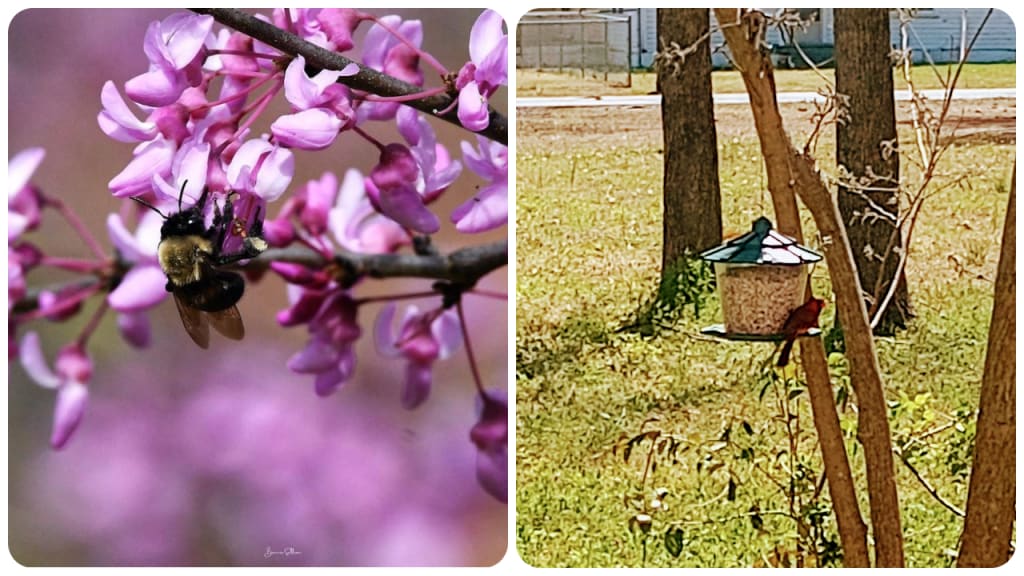Planting the Ecosystem
The Birds and the Bees

With spring upon us, the earth is coming to life again. The air is filled with the sounds of buzzing and chirping and the wind lightly rustling through the trees. The land is full of color and rebirth and of course our cars, houses, and everything in between is covered in pollen. As you drive down the road, you may see fields of gorgeous flowers and wonder just how did they get there? Put simply, the birds and the bees.
Spreading angel messages, confidence, and friendship, the cardinal became the NC state bird in 1943; Illinois, Indiana, Kentucky, Ohio, Virginia, and West Virginia have also chosen the cardinal for their state bird.
The cardinal, along with its eighteen subspecies, contribute to the ecosystem we live in by spreading the various fruit and vegetable seeds they consume through their fecal matter as they fly about. Cardinals are also a big help in the garden as they help cull the boll weevil, caterpillar, and cutworms populations. They act as prey to feed the local squirrels, domesticated cats and dogs, and even other species of birds. Cardinals are a joy for bird watchers to have in their backyard given the proper bird feed.
Though it may seem cruel to the human eye, cardinals are one of the many species prey to having the parasitic cowbird laid in their nest. Although we may wish to intervene, the cowbird is protected under the Migratory Bird Treaty Act as it is a native to North America. A special permit is required to remove the eggs and is usually only granted if the population is affecting other endangered bird species.
Bees symbolize hard work, productivity, and abundance. They also represent prosperity and aptly so because the world would no longer be prosperous without them. From carpenter bees to honeybees and the thousands of species in between, these busy buzzers pollinate 80% of the worlds' flowering plants; some of which cannot be pollinated by human hand. In 2016 Fox News reported that without bees we would lose important crops such as apples, almonds, blueberries, cherries, avocados, cucumbers, onions, grapefruit, oranges, and pumpkins.
This over-dependence on the bee population tends to lead to panic when people hear that globally, 40% of bee species risk going extinct. A "Save the bees" campaign is sweeping the nation and rightfully so, but there are over 4,000 native bee species and yet we seem to focus on the honeybee. Sam Black, executive director of Xerces Society for Invertebrate Conservation, once said "raising chickens to save the birds" will not fix the problem and the same goes for raising honey bees in attempts to save the bee population as a whole.
Since the days of colonization, we have brought over non-native bees like the honeybee to the extent that honey bees were once called "white man's flies" because the bees would arrive to the mainland well before the boats. There have never been as many honeybees in the past as there are now. Similar to the way settlers brought over diseases and illnesses that the native people had never experienced before, the non-native honey bees are doing the same to many native bee species. Thus slowly leading to the decline of the thousands of native species in North America alone.
Some species, such as the rusty patched bumblebee, have become protected under the Endangered Species Act due to the decline in native plants and housing.
According to Jim Cane, head of Wildbeecology, we should be planting native flowers and keep in mind that we're keeping honey bees for ourselves and not to save the bees.
While there are several other birds and insects that help contribute to our ecosystem, the bee and the cardinal are the insect and bird of the month for me. Tune in next month to see who I choose next. To make a suggestion, email me at [email protected] with the subject line "Bird/Insect of the month". All sources for the article will be posted on my Weebly account (daisyhaven.weebly.com) after the article is posted here on Vocal.
About the Creator
Cheyenne Harbison
I am 25 years old and living in NC. I've always loved writing about various topics that interest me and sharing with people. For updates on new releases, find me on Instagram at daisydragonflower. Enjoy my work!






Comments (1)
I was surprised to see my article posted the same day I sent it in, this will actually be the insect and bird for the month of April.